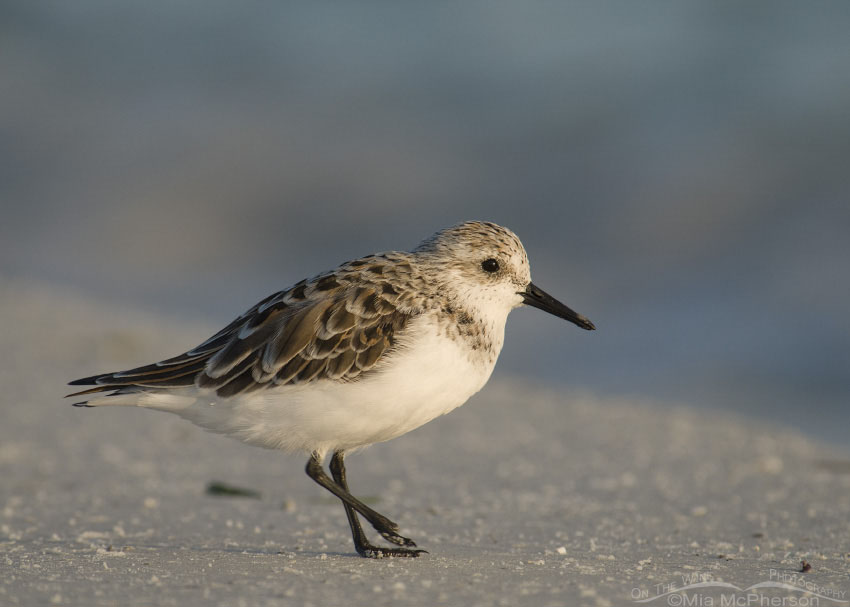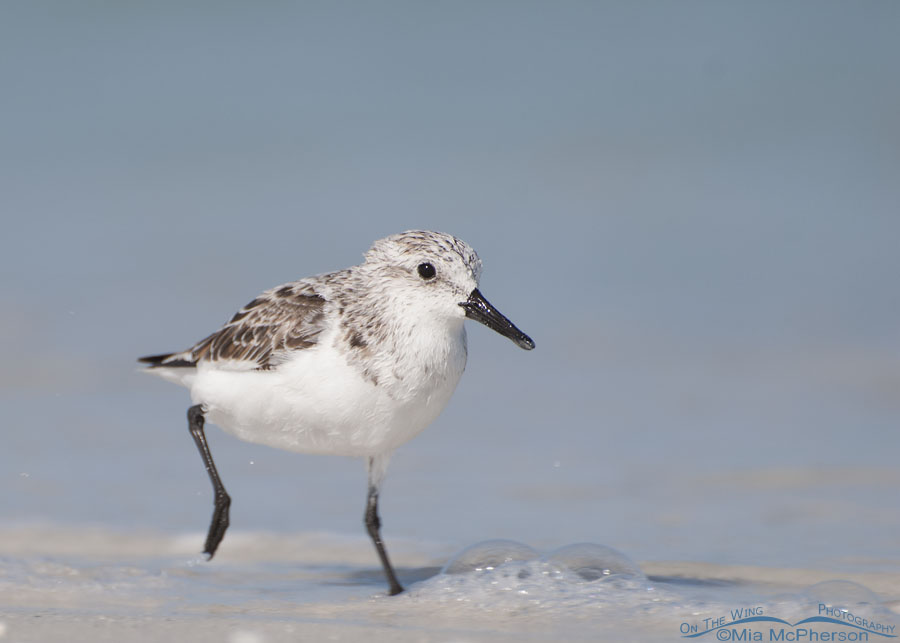
Sanderling Images, Facts and Information:
Calidris alba
- Sanderlings are small sandpipers with black legs, stout black bills and they appear very plump. They are very pale and grayish in nonbreeding plumage while in breeding plumage they are black, white and rufous.
- Sanderlings are migratory. They breed in the tundra of the high Arctic in Canada and rarely Alaska. Their breeding habitat includes island and peninsulas that have moist sites with plentiful vegetation. Winter habitat for Sanderlings are coastal areas of North, Central and South America and the Caribbean.
- The diet of Sanderlings includes crabs, amphipods and small crustaceans, polychaete worms, mollusks, and horseshoe crab eggs, flying insects, beetles, butterflies and moths. They will also eat plant material when other prey is not available.
- Sanderlings lay 3 to 4 eggs which hatch in 24 to 31 days. They are monogamous but at times the females will breed with more than one male. Both sexes have incubation patches. Some times the female will leave the first male to incubate the first brood and she will incubate a second brood.
- A group of Sanderlings can be called a “grain” of sanderlings.
- The oldest Sanderling was recorded to be just over 13 years.
I hope you enjoy viewing my Sanderling photos.
Sanderling in a sea fog
Title: Sanderling in a sea fog
Location: Fort De Soto County Park, Pinellas County, Florida
Date: 5/15/2009
Breeding plumage Sanderling on seashells
Title: Breeding plumage Sanderling on seashells
Location: Fort De Soto County Park, Pinellas County, Florida
Date: 5/15/2009
Sanderling in sea fog
Title: Sanderling in sea fog
Location: Fort De Soto County Park, Pinellas County, Florida
Date: 5/15/2009
Sanderling with marine worm
Title: Sanderling with marine worm
Location: Fort De Soto County Park, Pinellas County, Florida
Date: 5/3/2009
Sanderling on a sea of blue
Title: Sanderling on a sea of blue
Location: Fort De Soto County Park, Pinellas County, Florida
Date: 5/3/2009
Sanderling nearly in breeding plumage
Title: Sanderling nearly in breeding plumage
Location: Fort De Soto County Park, Pinellas County, Florida
Date: 5/3/2009
Sanderling with sparkles
Title: Sanderling with sparkles
Location: Fort De Soto County Park, Pinellas County, Florida
Date: 4/26/2009
Sanderling speeding by
Title: Sanderling speeding by
Location: Fort De Soto County Park, Pinellas County, Florida
Date: 4/26/2009
Sanderling racing the waves
Title: Sanderling racing the waves
Location: Fort De Soto County Park, Pinellas County, Florida
Date: 4/26/2009
Nonbreeding plumage Sanderling
Title: Nonbreeding plumage Sanderling
Location: Fort De Soto County Park, Pinellas County, Florida
Date: 4/26/2009
Sanderling feeding next to the Gulf
Title: Sanderling feeding next to the Gulf
Location: Fort De Soto County Park, Pinellas County, Florida
Date: 4/26/2009
Sanderling and seashells
Title: Sanderling and seashells
Location: Honeymoon Island State Park, Pinellas County, Florida
Date: 2/8/2009
Wading Sanderling
Title: Wading Sanderling
Location: Fort De Soto County Park, Pinellas County, Florida
Date: 13/30/2008
Resting Sanderling
Title: Resting Sanderling
Location: Fort De Soto County Park, Pinellas County, Florida
Date: 12/1/2008
Sanderling on Pen Shell
Title: Sanderling on Pen Shell
Location: Fort De Soto County Park, Pinellas County, Florida
Date: 12/7/2008
Sanderling feeding on a Pen Shell
Title: Sanderling feeding on a Pen Shell
Location: Fort De Soto County Park, Pinellas County, Florida
Date: 12/7/2008
Sanderling at dawn
Title: Sanderling at dawn
Location: Fort De Soto County Park, Pinellas County, Florida
Date: 11/23/2008
Misty morning Sanderling
Title: Misty morning Sanderling
Location: Fort De Soto County Park, Pinellas County, Florida
Date: 10/8/2008
Running Sanderling
Title: Running Sanderling
Location: Fort De Soto County Park, Pinellas County, Florida
Date: 9/25/2008
Sleeping juvenile Sanderling
Title: Sleeping juvenile Sanderling
Location: Fort De Soto County Park, Pinellas County, Florida
Date: 9/25/2008





















